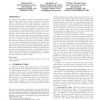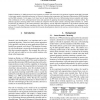50 search results - page 5 / 10 » Novel Semantic Features for Verb Sense Disambiguation |
CORR
2004
Springer
13 years 7 months ago
2004
Springer
This paper describes the National Research Council (NRC) Word Sense Disambiguation (WSD) system, as applied to the English Lexical Sample (ELS) task in Senseval-3. The NRC system ...
CIVR
2009
Springer
14 years 2 months ago
2009
Springer
To support more effective searches in large-scale weaklytagged image collections, we have developed a novel algorithm to integrate both the visual similarity contexts between the...
LREC
2010
13 years 8 months ago
2010
Schulte im Walde et al. (2008) presented a novel approach to semantic verb classication. The predicate argument model (PAC) presented in their paper models selectional preferences...
ACL
2006
13 years 8 months ago
2006
This paper designs a novel lexical hub to disambiguate word sense, using both syntagmatic and paradigmatic relations of words. It only employs the semantic network of WordNet to c...
CICLING
2009
Springer
14 years 8 months ago
2009
Springer
We propose a supervised word sense disambiguation (WSD) system that uses features obtained from clustering results of word instances. Our approach is novel in that we employ semi-s...


